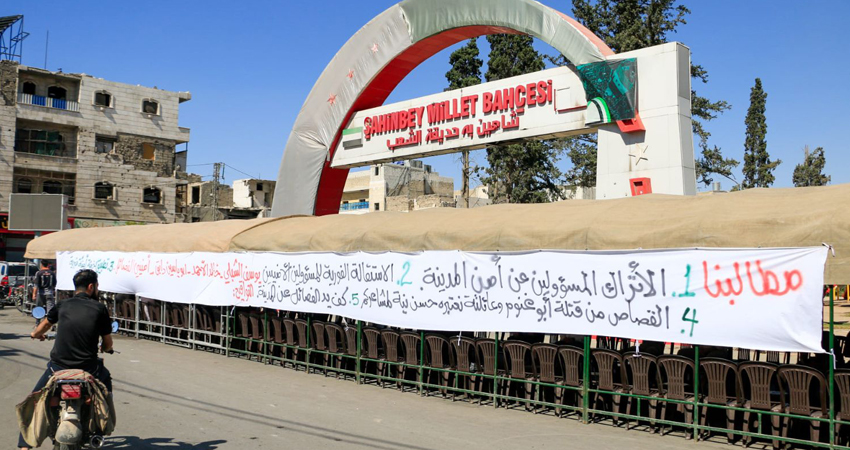On 7 October 2022, an armed group assassinated the Syrian media activist Muhammad Abdul Latif, locally known as Muhammad Abu Ghannoum, and his pregnant wife in broad daylight in downtown al-Bab, east of Aleppo province.
The assassination triggered growing concerns among journalists and media activists across northwestern Syria, especially since local sources have all agreed that the perpetrators killed Abu Ghannoum for his work and scathing criticism of the performance of the local authorities—particularly the opposition’s Syrian National Army (SNA).
The tragic fate of the journalist and his wife shook the local community and remains an unsettling event even though hazards and restrictions are familiar aspects of media work in the area, where the SNA dominates using a gag policy, prohibiting all media workers from talking about violations in the area.
The assassination alarmed locals, especially media workers, due to the involvement of the al-Hamza/al-Hamzat Division, which is one of the major armed groups operating under the flag of the SNA.
The assassination continues to enrage the media community and locals because it has been months since the investigations revealed the perpetrators to be affiliates of the al-Hamza/al-Hamzat Division, and authorities captured them but still brought none of them before the court.
In response, locals and journalists are demanding accountability and truth, calling for not only the persecution of the perpetrators but also all those involved in the shooting of the journalist, including those who ordered and planned the assassination.
However, the demands have not been fulfilled or met peacefully. Instead, the al-Hamza/al-Hamzat Division has been threatening journalists in a further crackdown on their right to freedom of expression and reporting on the reality in their area.
In this brief report, Syrians for Truth and Justice (STJ) presents the accounts of four military and media sources. The sources spoke about the circumstances surrounding the murder of the media activist Abu Ghannoum and the challenges facing media workers in the aftermath of the assassination—especially the threats sent to those calling for holding the perpetrators accountable.
1. The Assassination of Media Activist Abu Ghannoum
On 7 October 2022, gunmen shot and killed the Syrian media activist Muhammad Abdul Latif, locally known as Muhammad Abu Ghannoum, and his pregnant wife while riding his motorcycle.
Only a few days after the assassination, the Military Police and the SNA’s 3rd Legion obtained footage from street-facing surveillance cameras. The visuals showed that the perpetrators followed Abu Ghannoum closely on the city streets before they fired their weapons at him from within a silver Hyundai Santa Fe.
Digging into the assassination, STJ obtained the first-hand account of a local from the al-Bab city, who was riding his motorcycle closely behind Abu Ghannoum seconds before he was shot. He narrated:
“At around 6:35 P.M. local time, I was riding my motorcycle with my family. We were at the Automatic Bakery roundabout in al-Bab, and Abu Ghannoum and his wife were nearly 50 meters ahead of us on their motorcycle. Their motorcycle flipped suddenly, and I thought they had an accident because I did not hear gunshots. When I got to them, I saw blood. Abu Ghannoum had passed away, but his wife was still alive. The ambulance was late, so a civilian car transported them to the main hospital, [namely the National Hospital in the al-Bab city, nearly 2 KM away from the assassination’s location]. His wife died in the hospital.”
The eyewitness added:
“At the time of the assassination, a Santa Fe car passed by Abu Ghannoum and his wife. However, I did not focus on its details because I thought they only had an accident.”
For further details about the assassination, STJ reached out to a commander within the SNA’s 3rd Legion. On the condition of his anonymity, the commander recounted:
“Following the assassination, the 3rd Legion immediately withheld the recordings of the surveillance cameras, intending to use them in the investigation. The Military Police were asked to monitor the investigation proceedings and inspect the surveillance footage. When we identified the perpetrators and discovered that the al-Hamza/al-Hamzat Division was involved, we were sure that the Military Police alone would not be able to proceed with the investigation given the powers the division possesses. Therefore, the 3rd Legion had to intervene. We tracked the three individuals involved in the assassination, [Haitham al-‘Akel, Akram al-‘Akel, and Anwar al-Fa’ouri], who are members of the division. We captured them in the al-Bab city following clashes. One of the members of the cell was injured during the clashes and transported to al-Bab city’s hospital, [The National Hospital].”
The commander added:
“A force from the 3rd Legion was deployed to the hospital to combat a potential assault by the al-Hamza/al-Hamzat Division to smuggle the injured out or even liquidate the cell and thus keep the details of the assassination undercover. Additionally, a group of media workers held a sit-in in front of the hospital, demanding that the cell be held accountable. At the time, the 3rd Legion and the Military Police interrogated the suspects and filmed their confessions.”
The commander added:
“During the interrogation, the suspects confessed to receiving the assassination orders from the security officer in the al-Hamza/al-Hamzat Division, [Muhammad Ahmad al-Mugeer], known as Abu Sultan al-Dairi. It turned out that al-Dairi was the mastermind behind the operation, while the person who executed it and fired the weapon was Haitham al-‘Akel, a former security official with the Islamic State (IS, and locally Daesh). After the cell admitted to the involvement of Abu Sultan al-Dairi, the SNA’s 2nd Legion handed him over to the Military Police. All those involved in the assassination are in the custody of the Military Police, but it is the 3rd Legion who is guarding and interrogating them because the al-Hamza/al-Hamzat Division is likely to attempt to either assassinate or get them out.”
The commander added:
“It is likely that the commander of the al-Hamza/al-Hamzat Division, Saif Abu Bakr, had instructed al-Dairi because al-Dairi is the division’s security arm and is constantly seen next to the commander during the group’s military and security meetings.”
For insights into the interrogation with al-Dairi, STJ reached out to a Military Police officer. He said:
“The interrogation with Abu Sultan al-Dairi—who gave the assassination order of Abu Ghannoum and his wife, started the moment he was arrested and is ongoing. However, there is massive pressure not to reveal the information he provides during the investigation. No one knows whether he has confessed to anything yet or not.”
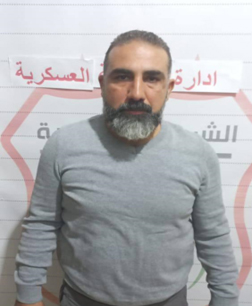 Image (1)- The security official within al-Hamza/al-Hamzat Division, Abu Sultan al-Dairi, after the Military Police arrested him in al-Bab city. Credit: Syria TV.
Image (1)- The security official within al-Hamza/al-Hamzat Division, Abu Sultan al-Dairi, after the Military Police arrested him in al-Bab city. Credit: Syria TV.
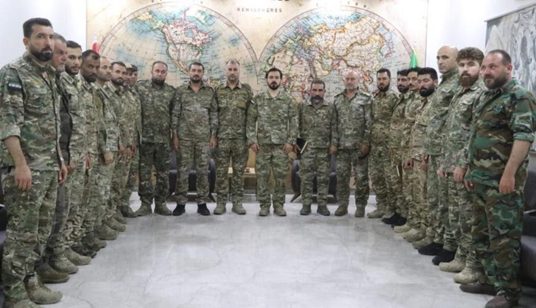 Image (2)- Abu Sultan al-Dairi during a meeting with the Commander of the al-Hamza/al-Hamzat Division, Saif Abu Bakr. Credit: Syria TV.
Image (2)- Abu Sultan al-Dairi during a meeting with the Commander of the al-Hamza/al-Hamzat Division, Saif Abu Bakr. Credit: Syria TV.
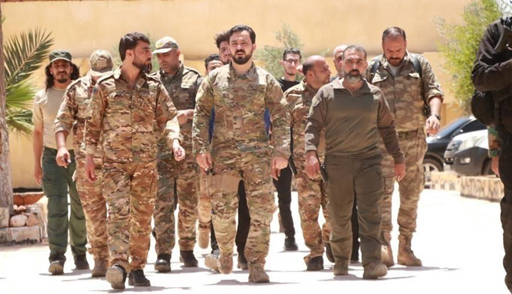 Image (3)- Abu Sultan al-Dairi during a meeting with the Commander of the al-Hamza/al-Hamzat Division, Saif Abu Bakr. Credit: Syria TV.
Image (3)- Abu Sultan al-Dairi during a meeting with the Commander of the al-Hamza/al-Hamzat Division, Saif Abu Bakr. Credit: Syria TV.
2. Likely Motives of the Assassination
The information STJ collected for this report indicates that Abu Ghannoum was likely assassinated for his opinions and criticism of the violations the al-Hamza/al-Hamzat Division perpetrates in the area.
A Military Police officer STJ met with for this report verified the retaliatory motivations underlying the assassination of Abu Ghannoum. He said:
“According to the investigations, the al-Hamza/al-Hamzat Division decided to assassinate Abu Ghannoum due to his activities and continued criticism of its performance, which the division believed was turning the popular incubator against it. Additionally, there was information saying that [Abu Ghannoum] was an editor with a local media outlet, [Ahtemlat News].[1] Furthermore, there was a feud between him and the division after he filmed a woman, saying she managed to restore her right, which was absorbed by a commander within the division called Abu Abdo al-Kadri.”
For a commentary on the disputes between Abu Ghannoum and the al-Hamza/al-Hamzat Division, STJ reached out to a photographer and media activist close to Abu Ghannoum. He narrated:
“[Abu Ghannoum] kept tabs on the drug trafficking cells of a commander within the al-Hamza/al-Hamzat Division, called al-Kadri. The issue started when the division refused to hand over a drug dealer to the Civil Police. The situation escalated when al-Kadri’s group stormed the house of a Civil Police officer and assaulted his mother and wife. People in al-Bab took to the streets in a massive protest against the assault. Abu Ghannoum was one of the protest’s organizers. During the protest, Abu Ghannoum and Abu Sultan al-Dairi had a row. The division arrested Abu Ghannoum due to the fight. Later, the Military Police intervened and released him.”
The activist added:
“There was this other incident. The brother of the commander of the al-Hamza/al-Hamzat assaulted a female nurse in al-Bab’s hospital. Abu Ghannoum organized another protest in the city against the assault. After this event, he started receiving death threats on his phone and to his social media accounts. He received the last threat only a few days before his assassination; a person he could not identify called him from an unknown number and threatened to kill him.”
The activist added:
“I believe there is an additional reason why Abu Ghannoum was assassinated. He used to organize protests against the Turkish military, who dug ditches in Tadef city to divide it into two enclaves, one controlled by the Syrian government and one by the SNA.”
3. Media Workers Struggling in the Throes of Fear
When the investigation revealed the cell behind the assassination and the involvement of the al-Hamza/al-Hamzat Division, media workers in the city protested in front of the hospital that treated an injured member of the cell. During the protest, they demanded justice for Abu Ghannoum.
One of the city’s well-known journalists circulated the information leaked about Abu Sultan al-Dairi’s role in the assassination. According to a military commander from the SNA’s 3rd Legion, this put the journalist’s life at risk, adding:
“The al-Hamza/al-Hamzat Division launched an extensive campaign to terrorize and silence media workers and activists. They also tried to kidnap one of the well-known journalists in the area but failed.”
STJ reached out to the journalist, who narrated how al-Hamza/al-Hamzat Division members assaulted him. STJ opted for withholding the journalist’s real name and alias for security reasons, as he said:
“During the protest [in front of the National Hospital in the al-Bab city], we tried to enter the building to speak with the injured member of the assassination cell. The hospital was full of fighters from the al-Hamza/al-Hamzat Division and the Aharar al-Sharqiya/Free Men of the East armed group. When I asked about the wounded person, members of the division assaulted me and forcefully pulled me away, trying to kidnap me. The attackers included Abu Sultan al-Dairi and al-Fa’ouri. Police officers and fighters from Ahrar al-Sharqiya/Free Men of the East intervened and helped me escape. I later called acquaintances within the 3rd Legion and told them about the incident.”
Following the assassination, several clashes erupted between the SNA’s 3rd Legion on the one hand and the al-Hamza/al-Hamzat Division, the Suleiman Shah Brigade (also known as al-Amshat), and Hay’at Tahrir al-Sham (HTS) on the other.
Within the context of the escalating tensions among the factions, the al-Hamza/al-Hamzat Division issued a strongly worded statement (See annex 1), threatening to persecute journalists publishing information about the assassination or backing the 3rd Legion.
A media worker from al-Bab shared with STJ his concerns, which only intensified after the assassination. He said:
“The assassination of Abu Ghannoum only increased the concerns of the majority of media workers in northern Syria. The assassination was a clear message to journalists and media activists that no matter how hard we try to act or speak out about the situation, our lives will remain worth a single bullet.”
The media worker added:
“Media workers in Aleppo’s northern areas were receiving threats one after the other. Additionally, the al-Hamza/al-Hamzat Division issued a statement accusing journalists critical of their performance of being affiliated with and hired by the Levant Front/al-Jabha al-Shamiya. The division aimed its threat at all media workers. Furthermore, several media workers in the area received individual threats from commanders and fighters within the al-Hamza/al-Hamzat Division. They sent me a threat with my uncle, saying that the division will cut my tongue off for criticizing them.”
He added:
“The majority of media workers are scared and many of them have limited mobility within the city of al-Bab and Bza’a, in the Afrin area, and in places where the al-Hamza/al-Hamzat Division and the Suleiman Shah Brigade (also known as al-Amshat) have a presence since they have a security cooperation agreement.”
4. Media Work Prior to the Assassination
Media and human rights work has never been smooth or safe in northern Aleppo, which is home to dozens of media workers. Since Turkey established control in the area and granted the SNA factions free rein there, media work has become rife with security threats, to the extent that criticizing any of the SNA’s factions has turned into a charge worth arrest and even killing.
Commenting on the conditions of media work in the area, a media worker STJ met with said:
“To work as a journalist or photographer you must first obtain approval from the Military Police. The application for approval includes providing the police with information about your political stances, the entity you work for, and the aims of filming. However, approval does not guarantee ease of practice nor protection from the assaults of the factions. Any armed group can arrest and interrogate a media worker, showing almost no regard for police approval. Therefore, to avoid this, media workers must also obtain approval from the security office of whatever faction in control of the area.”
He added:
“Covering issues related to human rights and discussing violations perpetrated by the factions are of the most serious matters that highly threaten the safety of journalists, which can potentially lead to their arrest.”
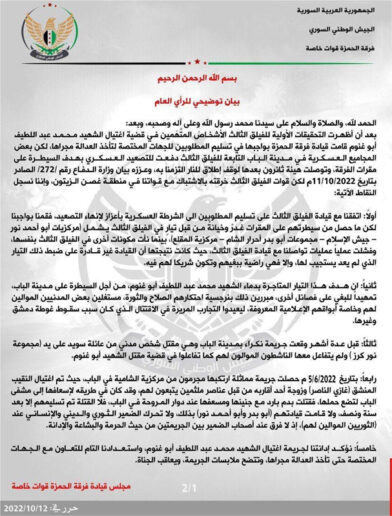
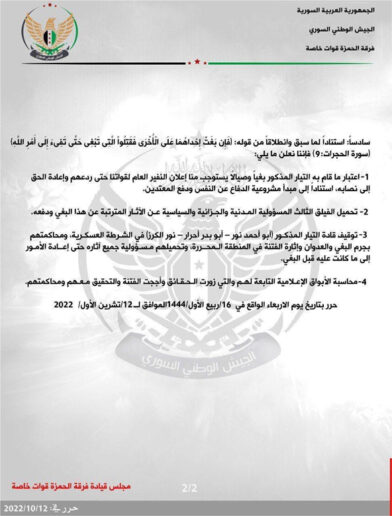 Annex 1- The statement the al-Hamza/al-Hamzat Division issued on 12 October 2022. Credit: The division’s official Twitter account.
Annex 1- The statement the al-Hamza/al-Hamzat Division issued on 12 October 2022. Credit: The division’s official Twitter account.
[1] An online outlet established in 2015 using social media to publish content. The outlet is mainly concerned with the corruption within the armed groups and violations perpetrated by their commanders. See the outlet’s Facebook account: https://www.facebook.com/AhtemlatNews/.

